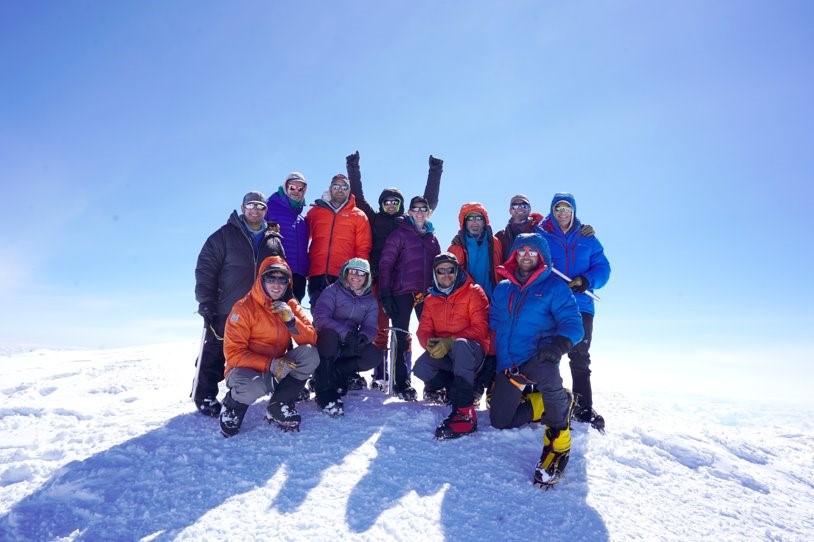For about a year, Kaleb Houck spent an hour every day after work walking on a treadmill at maximum incline with a 65-pound pack on his back. He was also working out an additional two or three hours each workday and spending 12 or more hours climbing various local mountain peaks on the weekends. Many of these ascents occurred during inclement winter weather. His favorite winter journey was a climb to Chicken Out Ridge on Mount Borah, where he dug through snow to build a fire to warm himself. This training ended up being the easy part of an adventure that culminated in a 19-day journey to the top of North America’s tallest point, Denali.
An avid climber and mountain enthusiast, Houck is also a digital twin research scientist at INL. In this role, he works on real-time digital representations of physical assets. These representations use sensor data to provide awareness from artificial intelligence and offer unique insights through advanced visualization, including virtual reality.
Although the Denali ascent is Houck’s biggest climb thus far, it wasn’t his first major climb, and he expects it won’t be his last. “One of the things I enjoy about climbing is that it gives me a definable goal to work toward,” said Houck. “Instead of just working out here or there, I can set a clear goal that I train for, and I’ll know unquestionably whether or not I was successful at achieving that goal.”
By the time he began his climb in May 2021, Houck had undergone extensive preparation. Even so, he noted that there was really no way to be fully ready for both the physical and emotional intensity of the experience. Houck’s team flew onto a glacier with no defined landing strip to begin the climb, so from the first day, they were surrounded by ice and snow, which Houck described as a “disorienting experience.”



Houck faced one of the biggest challenges in his climb right away. He learned that he had underestimated his load during training. He had trained to carry a 65-pound pack on his back while pulling a 70-pound sled, but in reality, he was carrying a 70-pound pack and pulling an 80-pound sled.
“I started out essentially carrying my body weight in load, and it was a very hard adjustment,” said Houck. “Everyone on our team was roped together, so we don’t get to move at our individual pace, according to our own schedule. I couldn’t take a quick break whenever I needed to rest, like I could on my solo practice climbs.”
After a long day of climbing, the team was far from being able to rest. They needed to make camp, which involves a lot of digging – making space for the camp’s kitchen, bedrooms and bathroom. To make matters more challenging, all this labor was done while in a disorienting void of many different shades of white.
According to Houck, he discovered the importance of having mental models that accurately fit his environment during a climb of Idaho’s second tallest peak. Part of a rock face he was climbing broke off the mountain, causing him to fall about 15 feet and break his shoulder. This was right after he began working for INL, so he had to go out on short term disability very early in his career. “I didn’t adjust for being in a different mountain range under different conditions,” Houck said. “I made the mistake of never questioning or reevaluating how I thought about the climb, and because of that mistake, I suffered a life-altering injury.”
On June 13, Houck and his team successfully summitted Denali. They arrived early enough to enjoy about an hour alone at 20,310 feet on a wind-free day. As with every aspect of the climb, however, things did not necessarily get easier after the summit. While the team had 17 days to make it to the top of Denali, they only had two days to make it back down to the bottom. Their packs only got heavier on the way down as they picked up some gear they had left in storage caches at each base camp to lighten their loads on the way up the mountain. Trying to hit a weather window to be able to fly off the glacier meant they had to move incredibly fast, capturing only a few hours of sleep after a strenuous day of walking.
Although Houck’s work with digital twin research doesn’t have him climbing up and down 20,000+ foot mountain peaks, he did gain useful skills from his time on Denali that he believes he can apply to his day job. “The research I do requires me to work on lots of major, lengthy projects, which demand extensive planning for successful execution,” Houck said. “Planning and mapping out a climb and the training beforehand require a similar set of skills.”



Houck looks forward to many future climbs in his life and is hoping to hit the Himalayas at some point. He noted that any prospective Denali climbers should prepare for an emotionally complex journey.
“At any given time while climbing, a climber can be feeling a multitude of things – strength and determination, exhaustion and frustration, tiredness that could drive them to the point of despair,” he said. “This is something I had to work hard to prepare for, but it’s an incredibly worthwhile experience.”
Hobbies are fulfilling, and fulfilled people make more productive employees. Hobbies unearth hidden skills, alleviate stress, unite you with others, and improve quality of life — all things that will help you function better at work. Discover the stories and unique interests of just a few INL employees.





